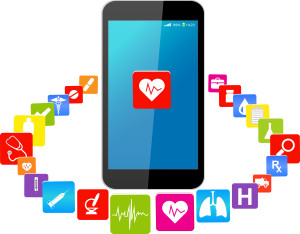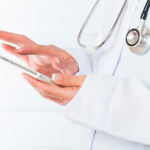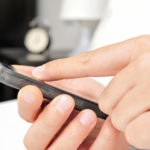 How long have you had your smartphone or iPad? If you were using one of these portable devices in 2008 you might have been an early Apple or iTunes App Store customer. The App Store launched in 2008 with 500 applications (apps); now there are over 1.4 million apps with more than 75 billion downloads. The first apps included Super Monkey Ball by Sega, Pangea’s Enigmo, and MLB At Bat by, of course, MLB. In the early days it was all about games and entertainment. Angry Birds may still be your favorite pastime, but apps have come a long way and now they may be part of the healthcare revolution.
How long have you had your smartphone or iPad? If you were using one of these portable devices in 2008 you might have been an early Apple or iTunes App Store customer. The App Store launched in 2008 with 500 applications (apps); now there are over 1.4 million apps with more than 75 billion downloads. The first apps included Super Monkey Ball by Sega, Pangea’s Enigmo, and MLB At Bat by, of course, MLB. In the early days it was all about games and entertainment. Angry Birds may still be your favorite pastime, but apps have come a long way and now they may be part of the healthcare revolution.
In the blog last week Terry wrote about the roll up of incentive and quality programs into the Merit-Based Incentive Payment System (MIPS), the new Sheriff in town. MIPS and value-based purchasing are ushering in a new age of data-supported, continuous care, whisking away volume-centered, episodic care. While CMS incentives and penalties push healthcare toward continuous care, patient engagement with smartphones and apps opens the door for personal continuous healthcare monitoring.
Data-driven self-care
With the availability of affordable, portable technology centered on the smartphone and similar personal devices, data-driven self-care is becoming a reality. Nano-sized computer technology combined with health-related software allow self-monitoring, a valuable component of continuous health care. Robust healthcare apps are already up and running on traditional smartphone platforms. Oscan, a Stanford product, enables a smartphone to capture oral cavity images to screen for oral cancers. Peek uses a smartphone and an inexpensive adaptor to support eye exams with retinal image capture outside of an ophthalmology office.
Have you purchased an Apple Watch? The Apple Watch was officially released on April 24, but the huge pre-orders make it likely you won’t see one on the shelf in the Apple store until mid-summer. The Apple Watch has more limited apps than your smartphone, but it can monitor your heart rate and track your workouts.
The democratization of health care
Eric Topol, MD, Medscape Editor-in-Chief frequently writes and speaks about digital tools that allow people to collect personal data leading to the “democratization of healthcare”. Democratization encompasses the “layers” of stored personal health information made possible by personal digital devices. Associated app software enhances the value of data with analysis, including trends and benchmarks. Personal monitoring can be continuous, decreasing the need for physician office visits. Smartphones and apps are changing the traditional “asymmetry” of personal health data. Patients no longer have to wait for an office visit and data interpretation and presentation by a physician.
Today, personal data capture is largely external physical and behavioral: number of steps, sleep patterns, heart rate, and food intake. At the recent Fresenius Medical Directors’ Meeting, Dr. Frank Maddux talked about two personal devices that open the door to more comprehensive assessment. Theranos is developing technology that uses a drop of blood to perform dozens of lab tests. New nanotechnology is being used to create glucose monitoring tattoos. Healthcare Informatics published Dr. Topol’s list of top personal health monitoring tools, including necklaces that monitor blood pressure, fluid status and cardiac output for congestive heart failure patients, handheld ultrasound devices, and “selfie” x-rays. Dr. Topol’s future includes “hospitalization by remote monitoring from your own bedroom.”
Cybermedicine
While driving home from work last Thursday evening I heard an NPR report on United Healthcare’s decision to provide coverage for virtual physician visits. NPR coverage included a story about parents who used the app “Doctors on Demand” to have a virtual pediatric visit for their daughter with Pink Eye. The virtual physician visit included a smartphone-assisted visualization of the patient’s eyes and throat. The United Healthcare spokesperson noted that this foray into cybermedicine coverage is being closely scrutinized for cost and utilization.
The current commercial for the Apple Watch presents the device as your communication connection. Text messages, images, and emoticons say hi, running late, I’m here, miss you, sorry! The commercial ends with a big red “I Love You” heart image. Future commercials may show the Apple Watch as your health watch and the big heart image will truly represent your beating heart.
Are you using any personal healthcare apps or virtual healthcare services? Are your patients collecting personal data? Do you have experience with any of these apps reported by PC Magazine to be changing healthcare?
- Doctor on Demand – providing video visits with physicians, psychologists, and lactation consultants
- HealthTap – providing virtual access to doctors to answer health questions (app now available on the Apple Watch)
- LiveHealth Online – providing telemedicine physician visits
- Microsoft Health Vault – app for medical record storage
- PillPack – online prescription-by-mail service that organizes pills into daily packs
- ping MD secure messaging, voice, and video app
Post a comment and let us know about your experience with cybermedicine.
 Dugan Maddux, MD, FACP, is the Vice President for CKD Initiatives for FMC-NA. Before her foray into the business side of medicine, Dr. Maddux spent 18 years practicing nephrology in Danville, Virginia. During this time, she and her husband, Dr. Frank Maddux, developed a nephrology-focused Electronic Health Record. She and Frank also developed Voice Expeditions, which features the Nephrology Oral History project, a collection of interviews of the early dialysis pioneers.
Dugan Maddux, MD, FACP, is the Vice President for CKD Initiatives for FMC-NA. Before her foray into the business side of medicine, Dr. Maddux spent 18 years practicing nephrology in Danville, Virginia. During this time, she and her husband, Dr. Frank Maddux, developed a nephrology-focused Electronic Health Record. She and Frank also developed Voice Expeditions, which features the Nephrology Oral History project, a collection of interviews of the early dialysis pioneers.



Leave a Reply